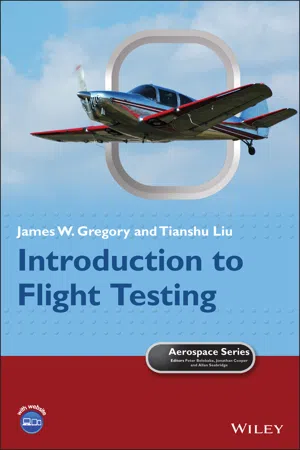
Introduction to Flight Testing
- English
- ePUB (mobile friendly)
- Available on iOS & Android
Introduction to Flight Testing
About this book
Introduction to Flight Testing
Provides an introduction to the basic flight testing methods employed on general aviation aircraft and unmanned aerial vehicles
Introduction to Flight Testing provides a concise introduction to the basic flight testing methods employed on general aviation aircraft and unmanned aerial vehicles for courses in aeronautical engineering. There is particular emphasis on the use of modern on-board instruments and inexpensive, off-the-shelf portable devices that make flight testing accessible to nearly any student.
This text presents a clear articulation of standard methods for measuring aircraft performance characteristics. Topics covered include aircraft and instruments, digital data acquisition techniques, flight test planning, the standard atmosphere, uncertainty analysis, level flight performance, airspeed calibration, stall, climb and glide, take-off and landing, level turn, static and dynamic longitudinal stability, lateral-directional stability, and flight testing of unmanned aircraft systems.
Unique to this book is a detailed discussion of digital data acquisition (DAQ) techniques, which are an integral part of modern flight test programs. This treatment includes discussion of the analog-to-digital conversion, sample rate, aliasing, and filtering. These critical details provide the flight test engineer with the insight needed to understand the capabilities and limitations of digital DAQ.
Key features:
- Provides an introduction to the basic flight testing methods and instrumentation employed on general aviation aircraft and unmanned aerial vehicles.
- Includes examples of flight testing on general aviation aircraft such as Cirrus, Diamond, and Cessna aircraft, along with unmanned aircraft vehicles.
- Suitable for courses on Aircraft Flight Test Engineering.
Introduction to Flight Testing provides resources and guidance for practitioners in the rapidly-developing field of drone performance flight test and the general aviation flight test community.
Frequently asked questions
- Essential is ideal for learners and professionals who enjoy exploring a wide range of subjects. Access the Essential Library with 800,000+ trusted titles and best-sellers across business, personal growth, and the humanities. Includes unlimited reading time and Standard Read Aloud voice.
- Complete: Perfect for advanced learners and researchers needing full, unrestricted access. Unlock 1.4M+ books across hundreds of subjects, including academic and specialized titles. The Complete Plan also includes advanced features like Premium Read Aloud and Research Assistant.
Please note we cannot support devices running on iOS 13 and Android 7 or earlier. Learn more about using the app.
Information
1
Introduction


1.1 Case Study: Supersonic Flight in the Bell XS‐1
Table of contents
- Cover
- Table of Contents
- Series Page
- Title Page
- Copyright
- dedication
- About the Authors
- Series Preface
- Preface
- Acknowledgements
- About the Companion Website
- 1 Introduction
- 2 The Flight Environment: Standard Atmosphere
- 3 Aircraft and Flight Test Instrumentation
- 4 Data Acquisition and Analysis
- 5 Uncertainty Analysis
- 6 Flight Test Planning
- 7 Drag Polar Measurement in Level Flight
- 8 Airspeed Calibration
- 9 Climb Performance and Level Acceleration to Measure Excess Power
- 10 Glide Speed and Distance
- 11 Takeoff and Landing
- 12 Stall Speed
- 13 Turning Flight
- 14 Longitudinal Stability
- 15 Lateral‐Directional Stability
- 16 UAV Flight Testing1
- Appendix A: Appendix AStandard Atmosphere Tables
- Appendix B: Appendix BUseful Constants and Unit Conversion Factors
- Appendix C: Appendix CStability and Control Derivatives for a Notional GA Aircraft
- Index
- End User License Agreement